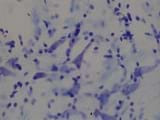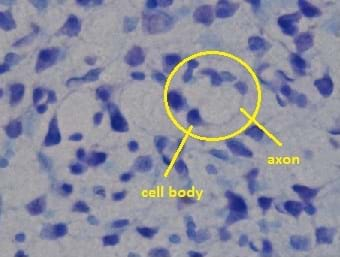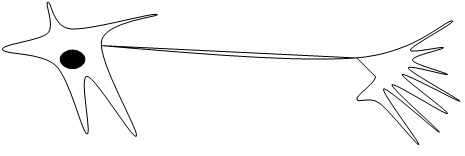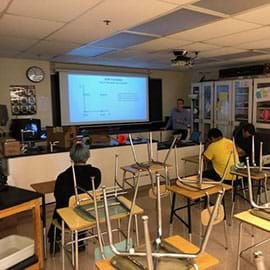Quick Look
Grade Level: 7 (5-7)
Time Required: 2 hours 45 minutes
(four 40-minute class periods)
Expendable Cost/Group: US $10.00 This activity also requires some non-expendable (reusable) items, such as a microscope and microscope slides; see the Materials List for details.
Group Size: 2
Activity Dependency:
Subject Areas: Biology, Life Science
NGSS Performance Expectations:

| MS-LS1-2 |

Summary
What does the brain look like? As engineers, how can we look at neural networks without invasive surgery? In this activity, students design and build neuron models based on observations made while viewing neurons through a microscope. The models are used to explain how each structure of the neuron contributes to the overall function. Students share their models with younger students and explain what a neuron is, its function, and how engineers use their understanding of the neuron to make devices to activate neurons.Engineering Connection
Biomedical engineers often create models to describe and illustrate what cannot be easily seen, such as neural networks in the brain. Biomedical engineers who develop neural devices design and build models and prototypes to help explain how devices are able to carry out the function of the neuron. Additionally, models are used for preliminary testing, prior to testing on live specimens.
Learning Objectives
After this activity, students should be able to:
- Design and build a model of a neuron.
- Explain the structures of a neuron and how each structure contributes to the overall function of neuron.
- List reasons why engineers use models to explain natural phenomenon.
Educational Standards
Each TeachEngineering lesson or activity is correlated to one or more K-12 science,
technology, engineering or math (STEM) educational standards.
All 100,000+ K-12 STEM standards covered in TeachEngineering are collected, maintained and packaged by the Achievement Standards Network (ASN),
a project of D2L (www.achievementstandards.org).
In the ASN, standards are hierarchically structured: first by source; e.g., by state; within source by type; e.g., science or mathematics;
within type by subtype, then by grade, etc.
Each TeachEngineering lesson or activity is correlated to one or more K-12 science, technology, engineering or math (STEM) educational standards.
All 100,000+ K-12 STEM standards covered in TeachEngineering are collected, maintained and packaged by the Achievement Standards Network (ASN), a project of D2L (www.achievementstandards.org).
In the ASN, standards are hierarchically structured: first by source; e.g., by state; within source by type; e.g., science or mathematics; within type by subtype, then by grade, etc.
NGSS: Next Generation Science Standards - Science
| NGSS Performance Expectation | ||
|---|---|---|
|
MS-LS1-2. Develop and use a model to describe the function of a cell as a whole and ways parts of cells contribute to the function. (Grades 6 - 8) Do you agree with this alignment? |
||
| Click to view other curriculum aligned to this Performance Expectation | ||
| This activity focuses on the following Three Dimensional Learning aspects of NGSS: | ||
| Science & Engineering Practices | Disciplinary Core Ideas | Crosscutting Concepts |
| Develop and use a model to describe phenomena. Alignment agreement: | Within cells, special structures are responsible for particular functions, and the cell membrane forms the boundary that controls what enters and leaves the cell. Alignment agreement: | Complex and microscopic structures and systems can be visualized, modeled, and used to describe how their function depends on the relationships among its parts, therefore complex natural structures/systems can be analyzed to determine how they function. Alignment agreement: |
International Technology and Engineering Educators Association - Technology
-
Students will develop an understanding of engineering design.
(Grades
K -
12)
More Details
Do you agree with this alignment?
-
Evaluate designs based on criteria, constraints, and standards.
(Grades
3 -
5)
More Details
Do you agree with this alignment?
-
Requirements for design are made up of criteria and constraints.
(Grades
6 -
8)
More Details
Do you agree with this alignment?
State Standards
Michigan - Science
-
Recognize that cells function in a similar way in all organisms.
(Grade
7)
More Details
Do you agree with this alignment?
Materials List
Each group needs:
- 1 mammal neuron cell slide, available for $7 each at http://www.carolina.com/histology-microscope-slides/mammal-neuron-motor-nerve-cells-smear-microscope-slide/313570.pr?catId=&mCat=&sCat=&ssCat=&question=mammalian+neuron
- microscope (if only 1 micorscope is availabe, share with the class)
- 2-3 sheets of graph paper
- Viewing the Neuron Worksheet
- Peer Review Checklist
- Presentation Preparation Guide
- Presentation Evaluation Form
To share with the entire class:
Note: To create their neuron models, have student groups select from the variety of materials listed below, or modify the list based upon your supplies availability.
- scissors
- 1-2 rolls tape (any kind)
- 1-2 packages pipe cleaners
- molding clay
- assortment of beads
- electrical or copper wire, 1spool
- string or yarn, 1 spool/skein
- assorted paint and brushes
- recycled newspaper or butcher paper
- assortment of Styrofoam balls
- computer with Internet access and projector, to show a short video
Worksheets and Attachments
Visit [www.teachengineering.org/activities/view/mis_neuron_lesson01_activity1] to print or download.Pre-Req Knowledge
A familiarity with the structure and function of a neuron, in addition to an understanding of the nervous system, is helpful. Students should also be able to create an at-scale drawing using graph paper.
Introduction/Motivation
To begin today's activity, we will watch a video clip about a robotic arm and a monkey. As you watch, think about how we can relate the monkey's actions to the possibilities of a human repeating those actions. (Show students this one-minute video clip that shows a monkey with a brain implant trained to use its brain to command a robot arm to feed itself marshmallows - just by thinking about it - at .)https://www.youtube.com/watch?v=sm2d0w87wQE
In this video you saw a monkey feed itself a banana without the use of his own arms. Instead, he thought about moving his arm, which sent signals to a computer. The computer interpreted these signals, and subsequently, moved the robotic arm. The monkey was able to move the robotic arm with his thoughts because of the activation of the neurons in his brain. Once this was discovered, many engineers thought about how the monkey could act as a model for humans.
In addition to using monkeys as models for humans, engineers also rely on rats as models to help them understand whether an LED light device could activate neurons inside the brain. Once engineers see that the device works with a rat, then they present what they learned and predict how the same technology might impact humans. We rely on various types of models, living and nonliving, to help us understand what is or what could be.
During this activity, you play the role of engineers who need a model to help others understand what is already known. Your task is to design and create a model of a neuron that will help you explain to others the structures of a neuron and how each structure contributes to the overall function of the neuron. To conclude the activity, you will meet with a younger student to teach him or her about the neuron and explain how your model can help engineers create devices that activate neurons.
Procedure
Before the Activity
- Gather model-making materials and microscope(s).
- Make copies of the Viewing the Neuron Worksheet, Peer Review Checklist, Presentation Preparation Guide, and Presentation Evaluation Form, one each per group.
- Before Day 4, arrange for your class to present its neuron model presentations to a younger group of students via video conferencing or a in-person visitation to another class in the school.
With the Students
Day 1
- Divide the class into groups of two students each, and assign each group to a microscope or determine an order in which they will share the existing number of microscopes.
- Discuss the Pre-Activity Assessment questions as a class: Why do engineers rely on models to show their thinking? What is a neuron and why is it important?
- Provide each group with a worksheet. (Note: Students should not answer question #3 on until Day 3 of this activity.)
- Guide students to view their brain tissue samples under the microscope(s). Have students complete their worksheet to support the development of their neuron designs. Once students reach the highest magnification, direct them to look for an image on their slide similar to that in Figure 1.

Figure 1. Neural tissue from a rat's cortex, at 50x magnification. - Using graph paper, have students draw an at-scale design for their models. Direct students to label their designs and include the following parts: dendrites, cell body, nucleus, axon and axon terminals.
Day 2
- Prior to the start of today's tasks, display materials available for the construction of the neuron model.
- Direct students to retrieve their design drawings from Day 1 and take a look at the available materials. Have students record the materials they want to use to represent each neuron structure by placing the name of the material next to the name of the structure. For example, a pipe cleaner may be used to represent the axon.
- Once their design plans are ready, that is, students have labeled their drawings with the materials they intend to use, have them begin to construct their models.
Day 3
- Begin the session with a peer review. Have student pairs partner up with another group, and use the peer review checklist, to evaluate the model of the other group. The team whose model is being reviewed is referred to as the "engineers" while the team doing the reviewing is referred to as the "reviewers." Remind students to record written feedback for each criterion. Feedback might include suggestions for improvement (such as, "It might be helpful to make the axon terminal more apparent") or compliments (such as, "You represented the axon with the pipe cleaner really well because it shows that it is long").
- Based on peer feedback, direct groups to use the remainder of the time to revise their designs and make any final changes and improvements.
- Hand out a presentation preparation guide to each group to prepare for the Day 4 presentation.
- Complete the Activity Embedded Assessment. Students may record their responses on a lined sheet of paper and turn it in prior to the conclusion of the day.
Day 4
- If possible, brief the class of younger evaluating students on how to complete the presentation evaluation form.
- Direct student partnerships to present their models to the student evaluators.
- Once all presentations have ended, have students critique the effectiveness of their own models by asking them the following questions:
- Do you believe your model was useful in helping you to explain the structures and function of the neuron? Why?
- What advantages did the model have in helping you to explain?
- What disadvantages did the model have in helping you to explain?
Vocabulary/Definitions
axon: A string-like structure that transports messages from one end of the neuron to the other.
axon terminal: A round structure at the end of the branches of axons that transports messages to the next neuron.
cell body: Surrounded by dendrites, contains the nucleus of the neuron.
dendrite: A branch-like structure that receives messages from other neurons.
model: A three-dimensional representation of a person, thing or proposed structure, typically on a smaller scale than the original.
neuron: A specialized cell that transmits messages throughout an organism's body.
structure: The arrangement of parts within a whole.
synapse: The gap between neurons in which messages are transported.
Assessment
Pre-Activity Assessment
Discussion Questions: As a class, discuss the following questions:
- Why do engineers rely on models to show their thinking? (Possible answers: Models are used to represent something else. A model of a neuron helps us to see what cannot be seen with the unaided eye. The model can be used to show the structure of the object and aid a person in describing the object's components and function.)
- What is a neuron and why is it important? (Example answer: A neuron is the cell that makes up the nervous system. It is important because it causes messages to travel throughout an organism. Those messages are analyzed and stored in the brain, and the brain sends a response back to other parts of the organism.)
Activity Embedded Assessment
Neuron Diagram: Direct students to complete question #3 on the Viewing the Neuron Worksheets (draw a diagram of a neuron; see Figure 2 for example drawings). 
Exit Ticket: On a new sheet of paper, have students answer the following questions:
- What is the function of the dendrites? (Answer: Dendrites receive messages from other neurons.)
- What is the function of axon terminals? (Answer: Axon terminals send messages to other neurons.)
- Why it is important to understand the structures and the function of the neuron? Explain. (Example answer: Without an understanding of the neuron, we would not be able to know how organisms respond to stimuli. We would not understand why our bodies react when we touch something else. We would not know how to help people who have had nervous system injuries. We would not know how to use external devices to support people with nervous system injuries.)
Post-Activity Assessment
Presenting the Neuron: Have student groups present their models to younger groups of students who serve as evaluators. Have the evaluators complete the Presentation Evaluation Form. Student presenters are assessed on their knowledge and ability to present information to an audience based on the evaluators' ability to complete the listening guide.
Safety Issues
Remind students to be careful with scissors.
Troubleshooting Tips
To avoid running out of supplies, direct students to use supplies conservatively.
Activity Extensions
Presentation Preparation Guide: If you wish to make available extra credit points, have students turn in their presentation preparation guides and offer bonus points for their completion of the guide.
Activity Scaling
For lower grades:
- Deciding which supplies to use may overwhelm younger students; consider paring down the supply options to reduce students' indecision when designing.
- Have students present to their peers, rather than another class.
- Have students work in groups of three or four.
For upper grades:
- Have students work individually.
- Consider giving students a supply budget. Decide in advance what each supply will cost to "buy," thus introducing the idea of designing within constraints.
- Allow students to work on their models at home.
Subscribe
Get the inside scoop on all things TeachEngineering such as new site features, curriculum updates, video releases, and more by signing up for our newsletter!More Curriculum Like This

In this lesson on the brain's neural networks, students investigate the structure and function of the neuron. They discover ways in which engineers apply this knowledge to the development of devices that can activate neurons.

Students learn about the first attempts at machine learning and specifically about the perceptron model—a simplified model of a biological neuron.
References
Buchen, Lizzie. "Neuroscience: Illuminating the Brain." Published online 5 May 2010; corrected online 30 June 2010. News Feature, Nature. Vol. 465, No. 6 (2010): pp. 26-28. Nature. Web 30 July 2013. (optogenetics) http://www.nature.com/news/2010/100505/full/465026a.html
Hopkin, Michael. "Monkeys Move Robotic Arm Using Brain Power: 'Brain-Machine Interface' Might One Day Help People with Disabilities." Nature News. Nature Publishing Group. 28 May 2008. Web 30 July 2013. http://www.nature.com/news/2008/080528/full/news.2008.861.html
"Nerve Regeneration." Nerve Regeneration-Introduction. Brown University Division of Biology and Medicine, RI. N.d. Web 12 July 2013. http://biomed.brown.edu/Courses/BI108/BI108_2001_Groups/Nerve_Regeneration/Introduction/Introduction.htm
Copyright
© 2014 by Regents of the University of Colorado; original © 2013 Michigan State UniversityContributors
Janelle OrangeSupporting Program
Robotics Engineering for Better Life and Sustainable Future RET, College of Engineering, Michigan State UniversityAcknowledgements
The contents of this digital library curriculum were developed through the Robotics Engineering for Better Life and Sustainable Future research experience for teachers under National Science Foundation RET grant number CNS 1300794. However, these contents do not necessarily represent the policies of the NSF and you should not assume endorsement by the federal government.
Last modified: May 10, 2017







User Comments & Tips